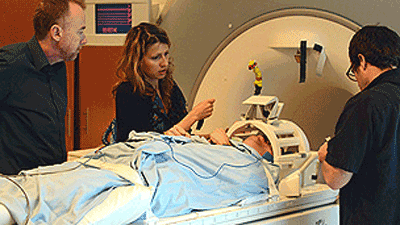Doctors communicate with vegetative patient using an fMRI machine
Marks first time uncommunicative patient has been able to give answers to outside world
Canadian doctors at the University of Western Ontario’s Brain and Mind Institute claim to have successfully opened a communicative channel with a severely brain-damaged, vegetative patient using fMRI, or functional magnetic resonance imaging.

Using fMRI, doctors have been able to establish conversation with a vegetative patient.
fMRI measures brain activity by detecting changes in the flow of oxygen-rich blood. Doctors thought it worthwhile to use this technology as a means for recording responses to a series of questions posed to Scott Routley, a hospital patient who has been in a vegetative state for more than 12 years due to a severe car accident.
Using technology to break down barriers
Doctors asked Routley to visualize playing tennis, and recorded the way his brain responded to this exercise using fMRI. They then asked him to visualize walking around his house and recorded the way his brain responded to that exercise.
With this data in hand, the doctors then told Routley to use these exercises as a means of responding to a series of yes or no questions; that is, visualize the tennis match when he means to answer yes, and visualize walking through his home to answer no.
They came up with this method after noting that different parts of the brain are used to conjure up different thoughts, with the first response taking place in the premotor cortex of the brain, and the second task taking place in the parahippocampal gyrus section.

Different mental exercises use different parts of the brain.
This disparity in results made it easy to tell Routley’s answers apart on fMRI scans, including the fact that he is not experiencing any pain while lying in his current state. This marks the first time a patient deemed vegetative has been able to tell scientists that he is not in pain.
Team leader on this study, Professor Adrian Owen, said that tests were run several times using the same question and answer process, and that the results indicate Routley was definitely communicating with Owen and his team.
Controversy
It should be noted that not everyone is on board with this solution. The most often cited reason: reading fMRI results is not an exact science just yet. Naysayers claim that it’s still too early to be sure that the results doctors see on the scans are definitely responses from the individual.
Also at issue is the possibility that some patients have been left to lie immobile for years under the staff’s assumption that said patient is unaware of the reality of their situation. It’s an unfortunate consideration to have to take, but if the team’s method described here proves effective, it’s something that will most definitely have to be addressed from this point forward. ■
Story via: bbc.co.uk
Advertisement
Learn more about Electronic Products Magazine






